x
Friday, February 26, 2010
What Can I Learn From The Bloopers?
Thursday, February 25, 2010
Location Justification (:
It was also very quiet so I knew we would have little or no interference (which we didn't during shooting apart from when we were outside the alleyway alongside Park Rd, a very long and busy road - see googlemaps and search "park road, spixworth").
The area around and overlooking to alleyway is very suburban and so i felt it fit the character's normal, comforting environment - yet it is morphed by nightfall. The fences along the alleyway also continue a fair way and are very high, this could link with the character feeling trapped or claustrophobic, running endlessly.
I then decided it would be a sensible idea to being filming before night fall as to establish which would be more suitable:
- filming in the light and darkening my film during the editing stage.
- or risk filming in the dark and hoping it will lighten during the editing stage.
We came prepared each night with an umbrella just in case the weather turned on us and so the camera would be undamaged and the filing unaffected (water droplets on lense). Also for health and safety during filing, an adult attended during filming with the knife - to warn of passers by and in case a passerby was to question our motive to carry a knife in an alleyway (':
Tuesday, February 23, 2010
Very First edit of Raw Footage
Comparative characters
 Image Two - Outfit
Image Two - Outfit Image Three - Shape and Personality Shown
Image Three - Shape and Personality Shown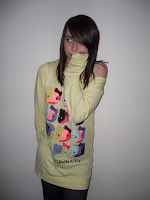 Image Four - Footwear
Image Four - Footwear Image Five - Hair
Image Five - Hair Image Six - Makeup etc
Image Six - Makeup etc
 Image Two - Outfit
Image Two - Outfit  Image Three - Shape and Personality shown
Image Three - Shape and Personality shown  Image Four - Footwear
Image Four - Footwear Image Five - Hair
Image Five - Hair  Image Six - Makeup etc
Image Six - Makeup etc
A femme fatale (French: [fam faˈtal], is an alluring and seductive woman whose charms ensnare her lovers in bonds of irresistible desire, often leading them into compromising, dangerous, and deadly situations. She is an archetypal character of literature and art. Her ability to entrance and hypnotize her male victim was in the earliest stories seen as being literally supernatural, hence the most prosaic femme fatale today is still described as having a power akin to an enchantress, vampire, female monster or demon.
Image Six: Hair and makeup for femme fatale was exaggerated, the eyeliner is bold and eccentric, it's carefully applied along with a lot of mascara, this AGAIN reflects her alluring, charming stereotype. She also has black nail varnish, i felt this would be dramatic and contrasting to her pale skin especially in extreme lighting and so would be effective in a Film Noir Genre. The Victim wore little mascara and lots of glitter which can be seen in the OTS ( coloured makeup not being an option in a B+W ots), glitter is a child/teenage accessory so thsi fits the character well. Her makeup also matched her nail varnish, both are pale and diverse in comparison to the femme fatale's.
Monday, February 22, 2010
On the Same Day..
two characters in my OTS played by the same person, the challenge being:
Make them as diverse as possible and challenge the audience to make a recognition - create questioning:
Are they related?
Are they clones? (haha!)
Is this deliberate?
The idea for my OTS is that these character's are doppelgangers, one pursuing the other, so i tried to make them as different as possible but still allowing the audience to make the link with ease.
Comparitive pictures in next post
Test shots
Thursday, February 11, 2010
Cinematography In A Nutshell.
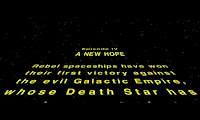
Box office Films of this past week.
week starting February 5th

Taken from IMDB:
United Kingdom Box Office Returns for the weekend starting 5 February 2010
It shows that The Princess and the Frog, Astro Boy, Invictus and Youth In Revolt are new entries while Avatar remains top film - £69,696,633 above the 2nd most popular.
And in Norwich the movies on show were the following:

From First to Tenth : Avatar, The Princess and The Frog, Wolfman, Youth In Revolt, Astro Boy, Day Breakers, Edge Of Darkness, Invictus, It's Complicated, My Name Is Khan.
Source: Odeon Cinema Listings Norwich
x
Wednesday, February 10, 2010
Storyboard (:
I'll alter this again before filming and then make alterations to the film and create a finished storyboard to fit my final OTS.
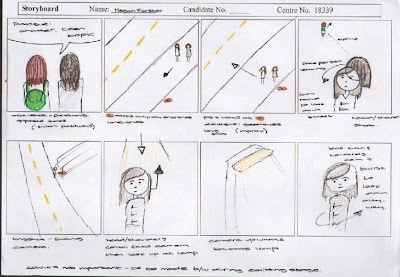
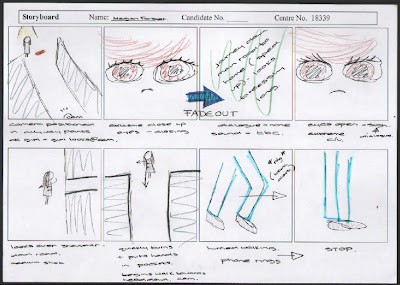

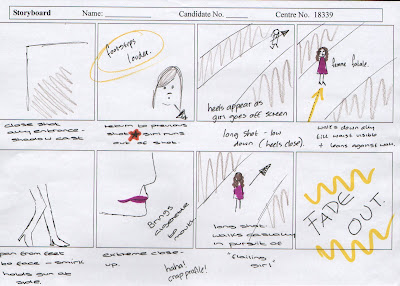
x
Saturday, February 6, 2010
Existing Film Noir Stills
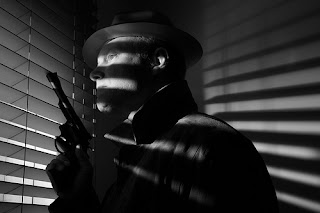 I really like how light has been used in this image, i recognise that it's not just been used in Film Noir but also crossed over into other genres such as "Horror" and "Thriller". I would love to include this in my own OTS but would need to branch into other locations and still make them appear to be one. Many films would involve travelling to different rooms as well as different cities and countries all-together to get certain scenes but still have to make them fit.
I really like how light has been used in this image, i recognise that it's not just been used in Film Noir but also crossed over into other genres such as "Horror" and "Thriller". I would love to include this in my own OTS but would need to branch into other locations and still make them appear to be one. Many films would involve travelling to different rooms as well as different cities and countries all-together to get certain scenes but still have to make them fit. This is a still image from "The Big Combo" which shows very effective use of silhouetting, which i experimented with in the previous post. You can see here than it masks the figure's faces but accentuates the femme fatale's feminine shape and the protagonist's costume and stature.
This is a still image from "The Big Combo" which shows very effective use of silhouetting, which i experimented with in the previous post. You can see here than it masks the figure's faces but accentuates the femme fatale's feminine shape and the protagonist's costume and stature.
 This is alike the shot i attempted at home, where half the face is lit while the other half bathed in shadow (moon phase - half moon). This would be very easy to include in my opening title sequence and very effective as a film noir convention.
This is alike the shot i attempted at home, where half the face is lit while the other half bathed in shadow (moon phase - half moon). This would be very easy to include in my opening title sequence and very effective as a film noir convention.
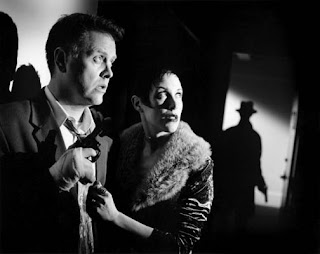
In this shot, light is cast across the faces of the two characters in the forefront while light is cast front behind someone in the doorway to cast a large shadow, this gives the impression that this person is larger and more intimidating than they may be, it creates tension and makes the audience fear what's behind the door. A director may do this to create fear or certain expectations of a certain character (villain).
x
Experimenting with Lighting
Creating shadow all depends on the position of the person, and the position/angles of the light source. I used a simple bed lamp and used black paper to concentrate the light, and in the first image i used a small umbrella and bounce the light (so the light isn't so focused on the figure), this can give diffuse the light more evenly or create a certain texture/softness to the light rather than the harsh light created when the light is focused.
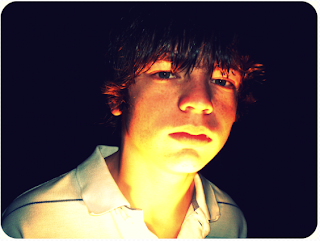
Image One: In this image, the light source is positioned at the bottom of the frame, pointed upwards. This way the bottom half of the face is bathed in light creating shadow around prominent facial features. If my character (OTS) was to use a mobile phone etc then this technique would be useful in lighting the face and creating mystery and shadow.
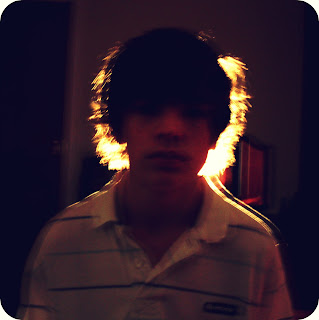
Image Two: In this image, the light is positioned behind the figure, this contrasts the foreground of the figure to the light source behind, and creates a brightened outline around the figure. As i am having a pursuit in my OTS this could be useful to show a figure approaching and creating (again) mystery and suspense, useful if i don't want to reveal the character's face clearly, instantly. By creating this silhouette, it creates tension - typical in Film Noir films. Image Three: In this image, the light is to the left of the figure, this way the left hand side of the face is lit - casting shadow across the right, unlit side of the face. This brings definition to the facial features and note that the right hand side of the face is only visible by outline.
Image Three: In this image, the light is to the left of the figure, this way the left hand side of the face is lit - casting shadow across the right, unlit side of the face. This brings definition to the facial features and note that the right hand side of the face is only visible by outline.
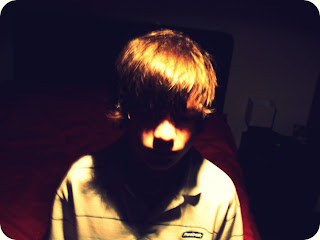
Image Four: In this image, the light is positioned above the figure, creating heavy shadow over the face and making the face difficult to distinguish. This could be very useful in my OTS when my figure is positioned under a street lamp etc as it again shadows the character's face, making them difficult to see clearly, and creates tension for the audience.
I am planning on used both the overhead lighting and the light source positioned below the face in my Opening Title Sequence - as they both create mystery and define the face, this i plan to use of my "victim", this way the audience can recognise facial expressions of worry and terror with ease, while the silhouette created by positioning the light behind i feel would be very effective to use on my femme fatale - this way the feminine silhouette would be highlighted and her face would also be shadowed to create more tension.
x
Tuesday, February 2, 2010
Analysis of Last Post
Yellowface, the key conflict involves the casting of the film, specifically Yellowfacing, which is the practice in American cinema, American theatre, and American television where Asian characters are portrayed by predominantly white actors.
The casting of white actors in the Asian-influenced Avatar universe triggered negative fan reaction marked by accusations of racism, "racebending", a letter-writing campaign, and a protest outside of a Philadelphia casting call for movie extras. Rathbone and producer Frank Marshall dismissed the complaints. Movie critic Roger Ebert was one of the ones critical of the casting. In February 2009, Dev Patel replaced McCartney, whose tour dates conflicted with a boot camp scheduled for the cast to train in martial arts.
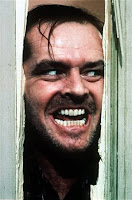
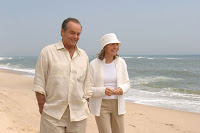

x






